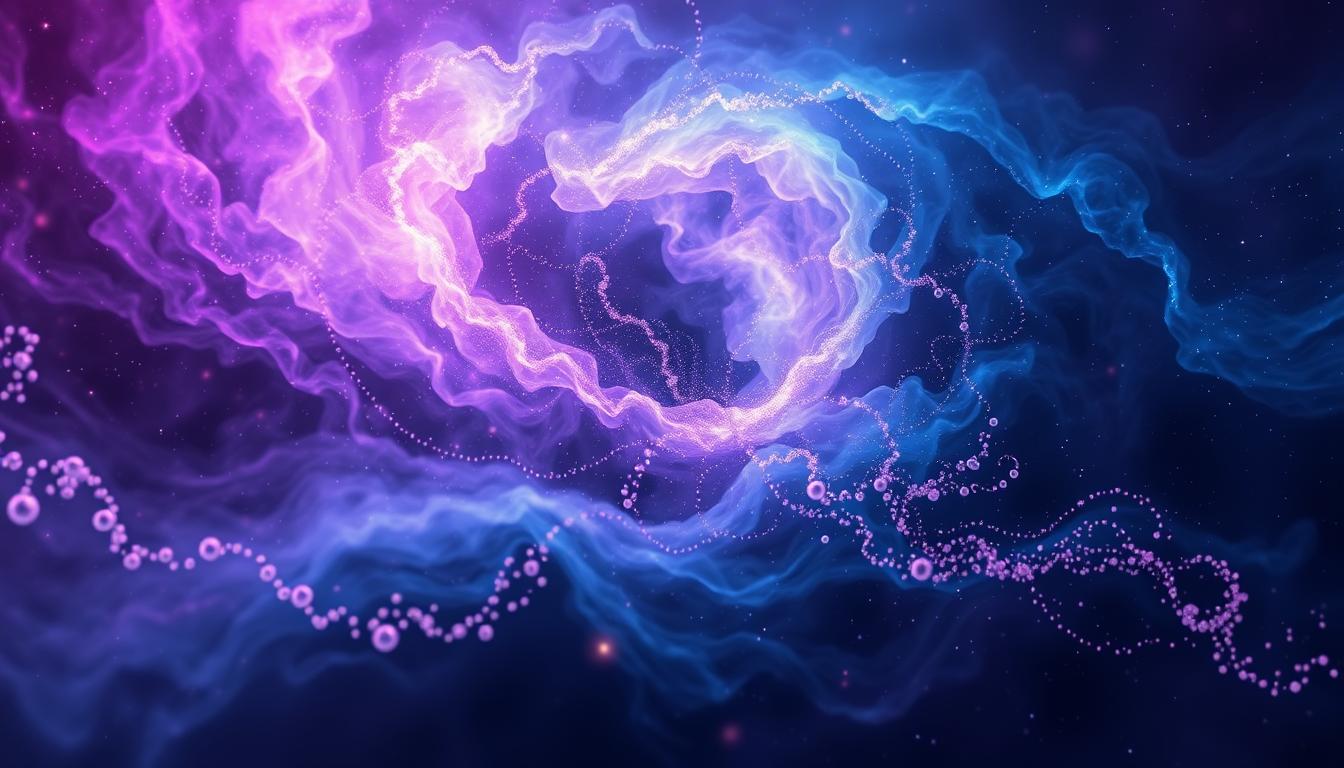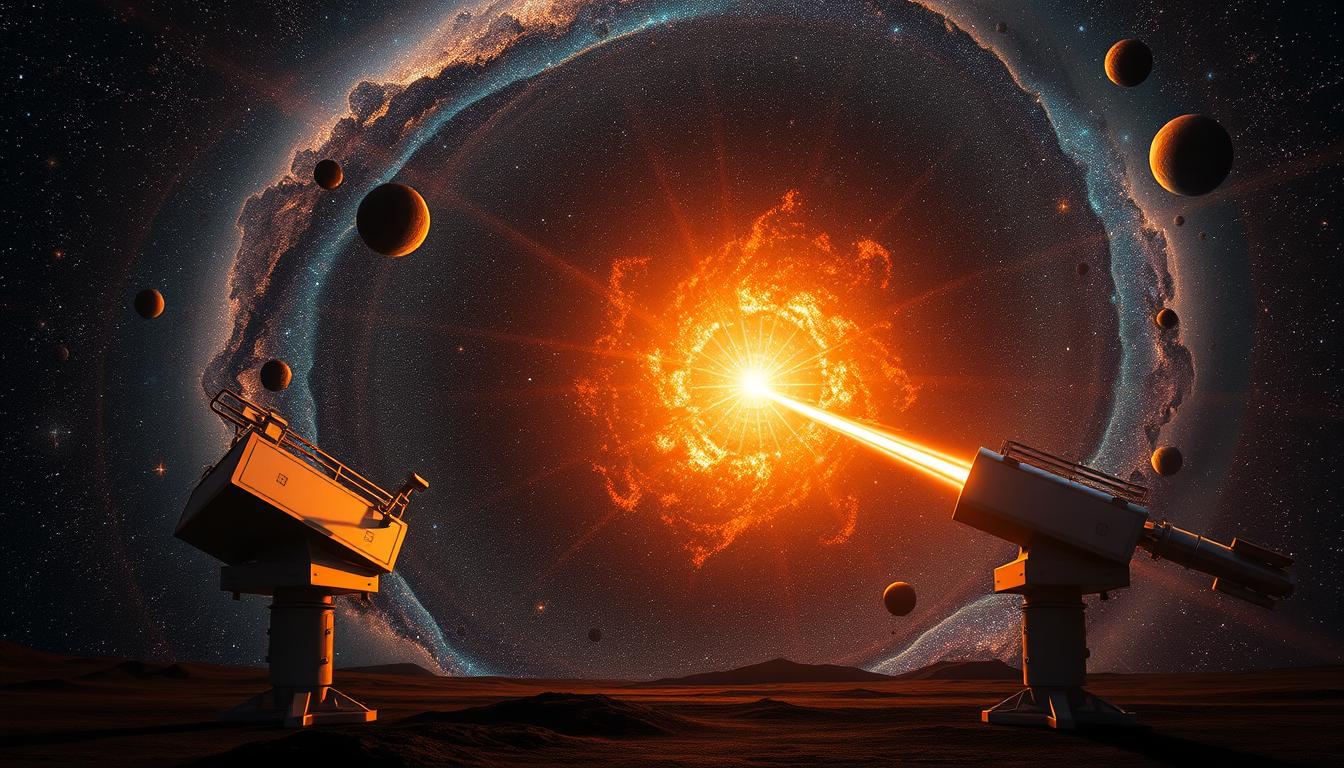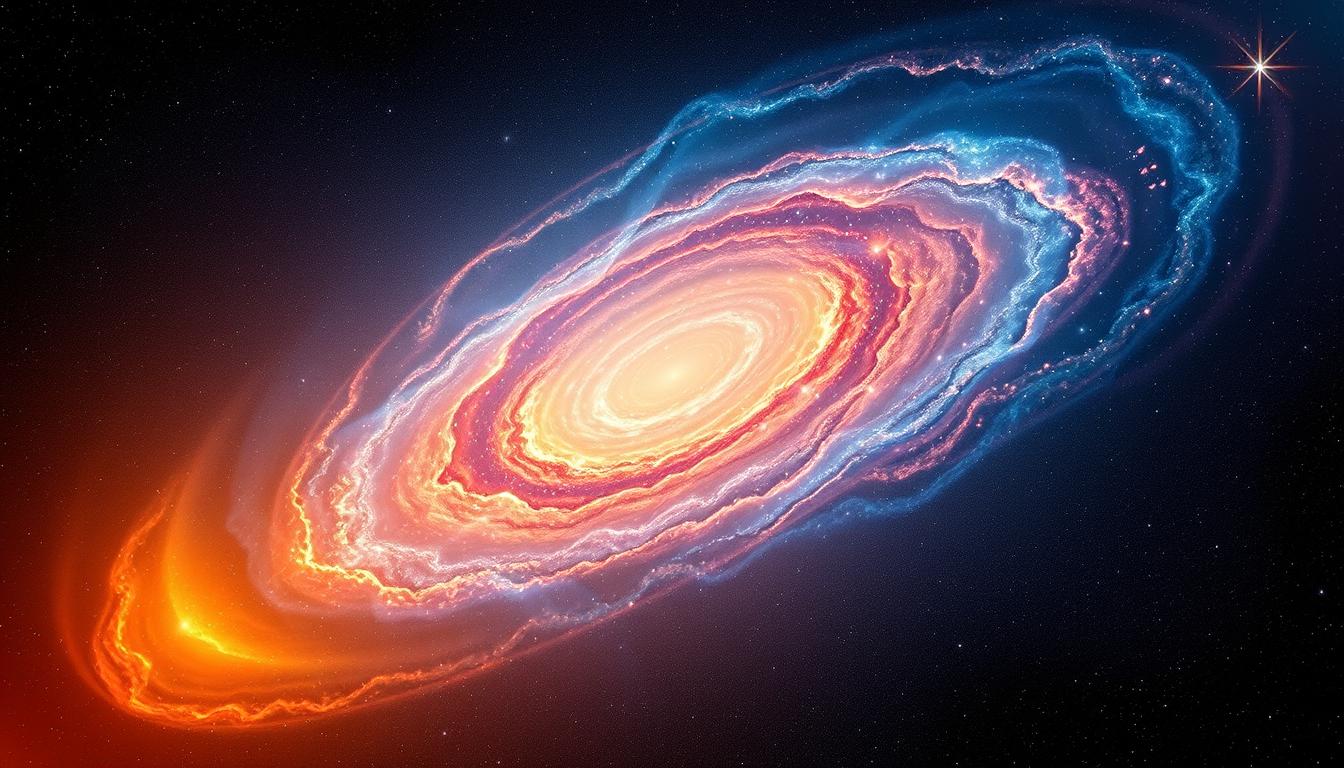Ever wondered what happens when dark matter particles collide with each other? We call this dark matter annihilation. It’s an interesting process because dark matter doesn’t interact with anything. We can’t see it, and we can’t even feel it out there in the universe. The only process they interact with something maybe with each other, and that could be groundbreaking.
Check this out, too: Dark Matter and Black Holes: What’s the Connection?
Dark matter makes up 85% of the universe’s matter. Dark matter particles can even pass through the Earth or Sun without a trace. However, scientists think that when two dark matter particles collide, they can annihilate each other. This releases energy in the form of gamma rays or other particles. That way, we can indirectly detect the existence of dark matter. After all, we discovered dark matter by how fast galaxies move.
Neutron stars, the dense remains of massive stars, might also help detect dark matter. Despite being only 20 km wide, they have a mass like our Sun. Their density makes them more likely to interact with dark matter, possibly causing temperature increases in old, isolated stars. It’s the same thing with what dark matter annihilation creates.

The Concept of Dark Matter Annihilation
Dark matter annihilation is basically two dark matter particles colliding with each other. When you think about it, dark matter makes up about 85% of the universe, and it should occur quite frequently. Imagine two weakly interacting massive particles (WIMPs) colliding and destroying each other – that’s what happens with the dark matter annihilation. It’s similar to how particles and antiparticles meet and turn into energy.
For this annihilation to happen, certain things need to be in place. The dark matter density must be high, and the particles must have enough energy to get past any barriers. These conditions are more likely in areas with lots of dark matter, like the center of galaxies or dark matter halos. We can’t see this close to Earth because the density isn’t high enough. It’s also one of the reasons why it’s harder to detect, as we can’t already see or feel dark matter. The farther away it is, the harder it gets to see the effects.
Particle-Antiparticle Annihilation
Understanding dark matter annihilation is easier when we compare it to particle-antiparticle collisions. When particles and antiparticles meet, they annihilate, turning their mass into energy. This follows Einstein’s famous equation, E=mc². Scientists use this knowledge to learn about dark matter and its interactions.

Conditions for Dark Matter Annihilation
For dark matter annihilation to work well, the dark matter density needs to be high. This is because the chance of two particles meeting increases with density. Also, the particles must have enough energy to get past any barriers. What are the probabilities of you accidentally hitting someone in New York Square during peak summer time and the chances of you hitting someone at a ranch in winter? The first one is much higher, right?
Generally, centers of galaxies or dark matter halos have a lot more dark matter than other parts of the universe. This is where the annihilation may happen. Advanced telescopes, like NASA’s Fermi Gamma-ray Space Telescope, have helped scientists find signs of dark matter annihilation.
Detecting Dark Matter Annihilation
Indirect detection is the main method to detect dark matter annihilation. This is because, after the annihilation, there are effects happening around the annihilation. We look for signs when dark matter particles collide and destroy each other, and these collisions can create particles like gamma rays.
Gamma-ray signals from the Galactic Center
The galactic center is a prime spot for dark matter searches. It has a lot of matter, including dark matter. Scientists use gamma-ray telescopes to look for a signal called the galactic center excess. The galactic center excess is an unexplained gamma-ray emission from our galaxy’s center. It could be from pulsars or cosmic rays, but some think it might be dark matter. Yet, it’s hard to tell, and we must study it more deeply.
The Role of Gamma-Ray Telescopes
Gamma-ray telescopes are tools that detect gamma rays, which are the most energetic form of light. Gamma rays cannot be focused with regular lenses or mirrors, unlike visible light. Instead, telescopes like the Fermi Gamma-ray Space Telescope track particles created when gamma rays interact with detectors. These telescopes are crucial in the search for dark matter annihilation. We believe that during and after annihilation, the process releases gamma rays. Gamma-ray telescopes look for unusual patterns or “excess” gamma rays. These patterns might reveal where dark matter is interacting.
In simple terms, gamma-ray telescopes are like detectives searching for clues in cosmic light. Their ability to “see” invisible, high-energy rays helps us understand one of the universe’s greatest mysteries: how to detect dark matter.

Implications of Dark Matter Annihilation
Dark matter annihilation could change how we see the early universe and how it evolved. Since dark matter is about 85 percent of the cosmos, its actions could greatly alter our understanding of the universe’s past. If dark matter particles were annihilated in the early universe, it could have changed how light elements formed. This process, called big bang nucleosynthesis, creates hydrogen and helium. The energy from annihilation might have left a small temperature mark in the cosmic microwave background, as physicist Tracy Slatyer and her team suggested.
Effects on Big Bang Nucleosynthesis and the Cosmic Microwave Background
Dark matter annihilation might leave clues in the universe’s earliest processes, such as Big Bang Nucleosynthesis (BBN) and the Cosmic Microwave Background (CMB). BBN created light elements like hydrogen and helium within the first minutes after the Big Bang. If dark matter particles annihilated in the past right after the Big Bang, they could have released energy that disrupted these reactions. Imagine cooking soup at the perfect temperature, and someone suddenly cranks the heat. The extra energy from dark matter annihilation could break apart, forming nuclei or alter their proportions, leaving a fingerprint in today’s element abundances.
The Cosmic Microwave Background is like a baby picture of the universe, showing how it looked 380,000 years after the Big Bang. Dark matter annihilation could have injected energy into the universe during this period, ionizing hydrogen atoms and delaying recombination—the process where atoms formed and the CMB was released. This added energy could blur the CMB or create little changes in its temperature and polarization patterns, like smudging a clear photo.

Conclusion
Dark matter annihilation can be that one piece of crucial information to solve dark matter. When dark matter particles collide and destroy each other, they release energy, often in the form of gamma rays or other particles. These effects can help us indirectly detect dark matter, even though we can’t see or touch it directly.
The effects of dark matter annihilation also affect the universe’s history. It could have impacted the Big Bang, which could alter the formation of elements like hydrogen and helium. The Cosmic Microwave Background may also carry marks of these annihilations, with energy injections leaving subtle temperature changes or patterns in the early universe’s radiation.
FAQ
What is dark matter annihilation?
Dark matter annihilation is when two dark matter particles collide and destroy each other. This process turns their mass into energy, like gamma rays. It could help us learn more about dark matter, a big mystery in physics.
How does dark matter annihilation differ from regular particle annihilation?
Dark matter annihilation is like regular particle-antiparticle annihilation. But since we don’t know what dark matter is, we’re not sure about the details. This includes what particles are involved and how much energy is released.
Where is dark matter annihilation most likely to occur?
Dark matter annihilation happens in places with lots of dark matter. This includes the center of galaxies and dark matter halos. These areas have more dark matter, making it easier for particles to collide and annihilate.
How are scientists searching for evidence of dark matter annihilation?
Scientists look for dark matter annihilation signs using indirect methods. They search for gamma-ray signals in areas with lots of dark matter, like the galactic center. Special telescopes help detect these gamma rays, which could show evidence of dark matter annihilation.
What is the galactic center excess, and how is it related to dark matter annihilation?
The galactic center excess is a big gamma-ray emission from the Milky Way’s center. It might be a sign of dark matter annihilation because the center has a lot of dark matter. But it’s hard to tell if it’s dark matter or other astrophysical sources.
How could dark matter annihilation have affected the early universe?
Dark matter annihilation in the early universe could have changed Big Bang Nucleosynthesis. This is how light elements like hydrogen and helium were formed. It could also have left marks on the Cosmic Microwave Background, the oldest light in the universe.